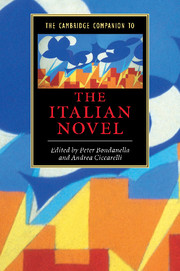Book contents
- Frontmatter
- 1 The belated development of a theory of the novel in Italian literary culture
- 2 The forms of long prose fiction in late medieval and early modern Italian literature
- 3 Alessandro Manzoni and developments in the historical novel
- 4 Literary realism in Italy
- 5 Popular fiction between Italian Unification and World War I
- 6 The foundations of Italian modernism
- 7 Neorealist narrative
- 8 Memory and testimony in Primo Levi and Giorgio Bassani
- 9 The Italian novel in search of identity
- 10 Feminist writing in the twentieth century
- 11 Italo Calvino and Umberto Eco
- 12 Literary cineastes
- 13 Frontier, exile, and migration in the contemporary Italian novel
- 14 The new Italian novel
- Index
- Series List
4 - Literary realism in Italy
Verga, Capuana, and verismo
Published online by Cambridge University Press: 28 May 2006
- Frontmatter
- 1 The belated development of a theory of the novel in Italian literary culture
- 2 The forms of long prose fiction in late medieval and early modern Italian literature
- 3 Alessandro Manzoni and developments in the historical novel
- 4 Literary realism in Italy
- 5 Popular fiction between Italian Unification and World War I
- 6 The foundations of Italian modernism
- 7 Neorealist narrative
- 8 Memory and testimony in Primo Levi and Giorgio Bassani
- 9 The Italian novel in search of identity
- 10 Feminist writing in the twentieth century
- 11 Italo Calvino and Umberto Eco
- 12 Literary cineastes
- 13 Frontier, exile, and migration in the contemporary Italian novel
- 14 The new Italian novel
- Index
- Series List
Summary
Realism or verismo? Basic assumptions and related problems
In late 1894 Giovanni Verga and Emile Zola (1840-1902), who had first met in Paris some twelve years earlier, were guests in Rome of Luigi Capuana. Capuana and Zola discussed literary theory to the veiled annoyance of Verga. When Zola ventured the opinion that Italian verismo and French naturalism were the same thing, Verga exclaimed: “Verismo, verismo . . . I prefer to call it the truth.” Many literary historians, having spent much time and ingenuity in discriminating between the two terms, would dispute Zola's opinion. Zola, Capuana, Verga, and other European nineteenth-century novelists, together with playwrights, poets, and visual artists outside the scope of this work, consciously followed a number of conventions and methodologies loosely called “realism,” whose various subcategories, however defined, all assume the artist's intention of modeling the artwork on life as it actually is.
This assumption raises intractable problems. Even if one was willing to take intentions into account, they tend to be undeclared, or obscured by lack of evidence. They may sometimes be reconstructed from the author’s work, but to use the work as evidence of the author’s alleged intentions in order to take them as material for its evaluation is a vicious circle. Declared intentions are often unrealized or largely at variance with the actual texts – and Verga’s, as we shall see, represent a case in point. Second, how does one model literature on life?
- Type
- Chapter
- Information
- The Cambridge Companion to the Italian Novel , pp. 61 - 74Publisher: Cambridge University PressPrint publication year: 2003



